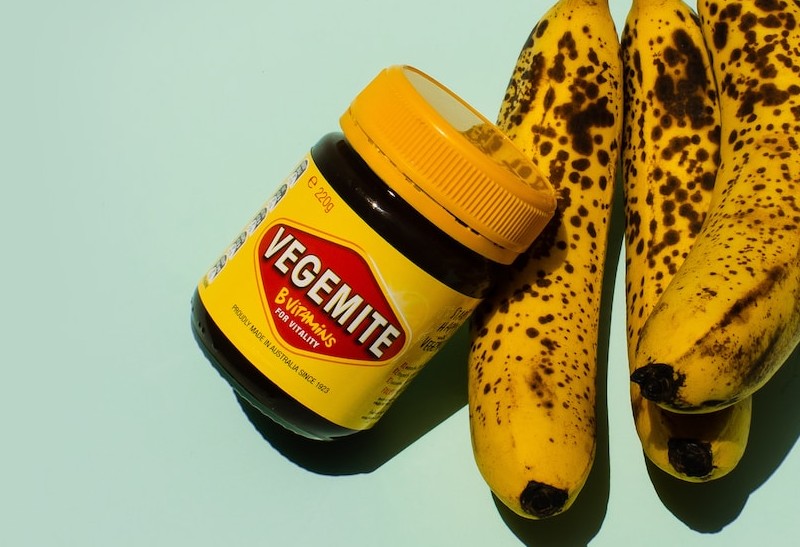What Does Vegemite Taste Like?
Quick Answer
Vegemite has a strong, salty, and umami-rich flavor with a hint of bitterness. It’s made from brewers’ yeast extract and various vegetable extracts, making it intensely savory. The taste is often described as malty or meaty, and it’s usually spread thinly on buttered toast or used in cooking to add flavor. While some people love its unique taste, others find it to be an acquired flavor.
What is Vegemite?
Vegemite is a food spread made from brewers’ yeast extract, a by-product of beer production, along with various vegetable extracts and salt.
It is dark brown, with a thick, paste-like consistency.
Originating in Australia, Vegemite is a staple in many Australian households and is commonly spread on toast, often with butter.
It’s known for its strong, savory, and salty flavor and is rich in B vitamins.
What Does Vegemite Taste Like?
Vegemite has a potent and complex flavor profile that can be jarring to those trying it for the first time. The most immediate flavors are salty and umami, which give the spread its signature savory taste. A touch of bitterness rounds out the flavor, providing a counterbalance to its saltiness. The umami quality, often described as meaty or broth-like, is due to the yeast extracts and various vegetable extracts used in its production. This depth of flavor is one reason why Vegemite is often used in cooking to enhance the taste of dishes.
Comparative Analysis with Other Spreads
- Marmite: Like Vegemite, Marmite is made from yeast extract but tends to be a bit more bitter and less salty. Marmite is also generally thinner in consistency.
- Promite: Promite has a somewhat milder, sweeter flavor compared to Vegemite and Marmite, but still maintains the yeast-extract base.
- Nutella: As a sweet, chocolate-hazelnut spread, Nutella is a complete departure from the savory profile of Vegemite. While Nutella is often spread generously on bread or pastries, Vegemite is typically used more sparingly due to its strong flavor.
What is The Texture Of Vegemite Like?
Vegemite is a dark brown, almost black, spread with a thick, paste-like consistency. Its texture is smooth but not oily, making it easy to spread thinly on bread or toast.
The consistency is somewhat akin to a very thick syrup or softened tar, and its opaque appearance means you can’t see through it.
The color and texture can be surprising to those who are new to the product, as it stands in stark contrast to lighter, creamier spreads like butter or cream cheese.
FAQs
How Is Vegemite Typically Consumed?
Vegemite is commonly spread thinly on buttered toast, bread, or crackers. It can also be used as a flavor enhancer in cooking, such as in soups, stews, and casseroles.
Is Vegemite Good For You?
Vegemite is rich in B vitamins, including B1, B2, B3, and folic acid. However, it is also high in sodium, so it should be consumed in moderation, especially by those who are watching their salt intake.
How Does Vegemite Differ From Marmite?
While both are yeast extracts, Vegemite is generally saltier and less bitter than Marmite. Marmite also has a somewhat thinner consistency and a slightly different nutritional profile.
Why Is Vegemite So Popular In Australia?
Vegemite has been part of Australian culture since its invention in the 1920s. It has been promoted as a healthy food rich in vitamins, and many Australians grow up eating it.
Can I Use Vegemite In Cooking?
Yes, Vegemite can be used to add a rich, savory flavor to various dishes, including soups, stews, and gravies. A small amount goes a long way due to its intense flavor.
Is Vegemite Vegan?
Traditional Vegemite is not vegan as it may contain traces of B12 sourced from animal products. However, there are vegan versions available in the market.
Is Vegemite An Acquired Taste?
Many people consider Vegemite to be an acquired taste due to its strong, salty, and umami-rich flavor. Some find it off-putting at first but grow to love it over time.
How Do You Store Vegemite?
Vegemite should be stored in a cool, dry place. Once opened, it has a long shelf life and does not need to be refrigerated.
What Are the Types of Vegemite?
Vegemite is primarily known for its classic variant, but there are also a few other types and formulations available in the market. Here’s a rundown:
- Classic Vegemite: The original formula, rich in B vitamins, and suitable for a variety of uses from toast to cooking.
- Reduced Salt Vegemite: A version that offers the same classic flavor but with less sodium, catering to those who are watching their salt intake.
- Vegemite Cheesybite: A blend of Vegemite and cream cheese, aimed at providing a milder, creamier flavor.
- Gluten-Free Vegemite: Formulated for those with gluten sensitivities or celiac disease.
- Vegan Vegemite: Specially designed to be free from animal products, this option caters to the vegan community.
Does Vegemite Taste Bad?
The question of whether Vegemite tastes “bad” is subjective and often tied to individual preferences and cultural experiences. People who grew up eating Vegemite or who enjoy strong, savory flavors may find it delicious.
On the other hand, those unfamiliar with its potent, salty, and umami-rich taste may find it unappealing upon first try. Many describe it as an acquired taste that grows on you over time.
Does Vegemite Taste Like Soya Sauce?
While both Vegemite and soya (soy) sauce share umami and salty flavors, they are distinct in taste and usage. Vegemite has a thicker texture, and its flavor profile includes a yeasty, almost malty note that isn’t present in soy sauce.
Soy sauce is liquid and has a more balanced, less intense saltiness, often with sweet or acidic undertones.
Though both are used to enhance the savory qualities of dishes, they are generally not interchangeable due to their distinct flavors and consistencies.



